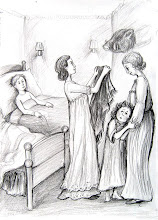Diment, Gayla. The Autobiographical Novel of Co-Consciousness: Goncharov, Woolf and Joyce. Gainesville University Press of Florida, 1994.
Diment states that through Woolf’s ability to detach herself from the story allowed her to become the “omniscient narrator” that To the Lighthouse needed in order to successfully allow Woolf’s true artistic self be reflected through Lily’s painting. The commentary states that Woolf integrates the same trend of thinking into Lily in the last section of the novel through the use of “poetic tropes” (105). Lily’s experience, when pondering what the mania for marriage that Mrs. Ramsay had, through the monologue created by Woolf, was one that reflected the thought trend that Woolf herself went through when developing her novels. According to Diment, Woolf doubted her ability to write throughout her career. In the development of To the Lighthouse Woolf constantly questioned if her novel had been too open for sentimentality; she felt this doubt because she knew that Mr. Ramsay’s character had been crafted to be almost identical to that of her father. She based the characters on people she knew and was involved with. One of the interesting marks that Diment makes is that which explains that Woolf crafted her characteristics to be split into two of the characters in the novel, Lily Briscoe, representing her more mature and analytical self and Cam as the child she in a way wished that she would have been. This connection is made because of the relationship that Mrs. Ramsay had with Cam, which was one that Woolf longed for with her own mother and didn’t have.
This commentary creates in the reader the understanding needed for reflection that is needed to captivate the essence that To the Lighthouse is capable of emiting. The essence is that of a woman whose mind is constantly traveling from the past, to the present, and to the future. It can be a hard concept to grasp simply by looking at the pattern that Lily uses when painting, but it becomes evident as Woolf allows more of herself to be known. The narrator tried to convey things in a manner that allowed the reader to think ethically through the manner in which Woolf integrates the art of words and rhythm into Lily’s mental activity as she ponders on things like Mrs. Ramsay and her views in marriage. The reading becomes more enjoyable and is able to infiltrate the desperation that Lily felt. The narrative goes beyond Lily’s mind and allows the reader to access more of Woolf’s desperation to break free from the oppression of a world that dictated to her who she should be and what she should do. In both, Lily and Woolf we can find that there is a need for freedom that restricts them from being accepted, but they remain true to themselves and pursue that which they need to accomplish in order to become satisfied and accomplished women. Freedom is concept that goes beyond physical captivity, one can be a prisoner of others and of our own minds. In To the Lighthouse freedom is accomplished for both, author and character. This type of freedom is hard to achieve, but Woolf accomplishes this through an artist that was once captive of the thoughts imposed on her, but has through her painting, as is Woolf's writing, become free.
Subscribe to:
Post Comments (Atom)



No comments:
Post a Comment